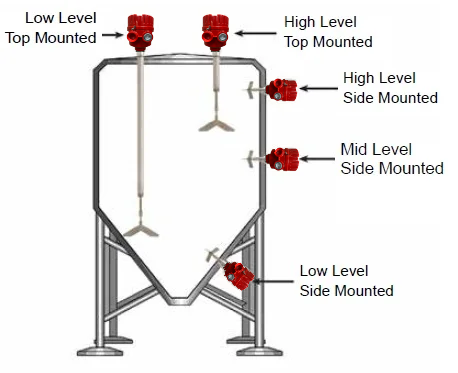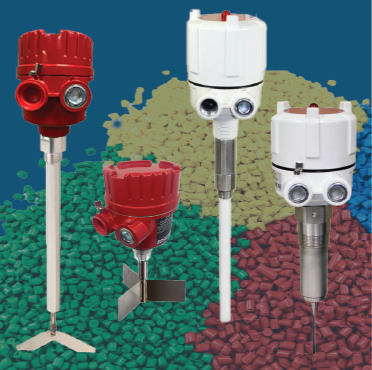Plant management and maintenance utilize point level sensors as a principal component in production process control. They can ensure a constant supply of material into a production process and prevent downtime when used as high, low, or mid-level sensor. They establish a safer workplace by eliminating the need to climb vessels when used together with an alarm like a light or horn.

Image Credit: Shutterstock/funfunphoto
Point level sensors are simple to install using an existing mounting connection, and many provide varied power supplies, which makes them convenient to wire to the existing electrical system. They may be within a company’s MRO budget as they are affordably priced, generally around a few hundred dollars. Whereas a complete inventory management system could need the approval of a capital expense.
They can be installed incrementally in a few vessels at a time, without a huge investment in either time or money, because they are so light and compact. An MRO purchase can usually be completed using a purchase order or a credit card without corporate approval.
Point level sensors play a key role in redundancy in an inventory management system, which is an often-overlooked advantage. Point level sensors can alert to probable overfills when used as a fail-safe, high-level indicator. Working together with continuous contact or non-contact sensors, these highly reliable devices can alert to a potential issue that could cause material waste, damage to the structure or expensive equipment, or other damage sensors in the vessel.
Rotary Level Indicators
Rotaries are a common and familiar device utilized for high or low-level point level indication in silos, bins, and tanks. They are flexible enough to use in most materials, from coarse, lump materials with bulk densities up to 150 lb/cu ft3, to powders and granules with a minimum bulk density of 2 lb/cu ft3.
BinMaster Rotary — BMRX 100, 200, 300 — Ultimate Point Level Indicators
Video Credit: BinMaster
The main use of rotaries is simple. The paddle rotates constantly until material reaches the paddle if the rotary is utilized to alert that material has reached a high level while the tank is filling. When the paddle encounters resistance because of the presence of material, it stops rotating and dispatches an alert via a horn, light, control room, or alarm panel.
When used as a low-level indicator, the paddle will start turning when material drops lower than the level of the paddle and then sends an alert or can be set-up to shut off a process system. It is necessary to use a rotary with a fail-safe feature to make sure you are alerted in the event of a rotary failure when tied to process control.
Rotaries are being applied in new and innovative ways more often. A vertical extension on a rotary means it can be extended as far as 12 feet down into the bin, tank, or silo, for high level detection at the interior of a vessel. This is recommended for a center-fill vessel when the function needs a certain amount of headroom.
When it is mounted on top of the vessel, a vertically-extended rotary can detect and alarm when material is higher toward the center of the container instead of simply identifying the level of material near the sidewall which could be at a higher level when emptying (cone down) and at a lower level when filling (cone up).
A horizontal extension permits a rotary to be utilized to calculate material levels through the sidewall, this is for use in thick tank walls, like in cement silos. When a collapsible paddle is combined with a horizontal extension, the rotary can be installed through a 1-1/4? or 1-1/2? NPT opening without entering the vessel.

A glass recycler using BinMaster rotaries for low, medium and high-level detection on silos containing glass.
Capacitance Probes
Capacitance sensors can easily be customized with different type of lengths, probes or extensions. They are designed for a variety of applications. These sensors may be used for high, mid-and low-level detection in chutes, silos, bins, tanks, hoppers, and other types of vessels where materials are flowing, stored, or processed.
Mini Capacitance Probe Point Level Measurement — BinMaster
Video Credit: BinMaster
Capacitance sensors work by identifying the absence or presence of material in contact with the probe by detecting small alterations (as low as 0.5 picofarad) in capacitance caused by the difference in the dielectric constant of the material versus the air. A wide range of options are available for capacitance probes.
If the application is in an area where there is excessive vibration or a high temperature environment, a capacitance probe that houses the probe and electronics in different enclosures is suitable. An flexible cable extension can be connected to a capacitance probe in situations when the sensor will be used for high, mid or low-level detection and is mounted on top of the tank. Alternatively, a flush mounted probe can be utilized in space-constrained or narrow areas or in applications where bridging or material flow could damage a standard probe.
When the vessel has internal obstructions or is small, a bendable probe can be used to allow enough probe surface area and avoid obstructions while still able to detect the presence or absence of any material.
Vibrating Level Sensors
The vibrating rod or vibrating level sensor is a piezoelectric driven vibration type level switch that can be utilized for level detection in silos, bins, and hoppers full of dry bulk solid materials.
Very lightweight, fluffy materials as light as 1.25 lb/cu ft3 (such as flakes and powders) or heavy materials such as pellets or granules can be detected by a vibrating level sensor. When there is an absence of material covering the active rod, vibrating rod level sensors vibrate. The vibration is suppressed when the rod is covered with material, and an electronic circuit make a relay switch and send an alert. The vibration restarts when the rod becomes uncovered, and the relay switches back.
Most vibrating rods do not need calibration and will easily adjust to the required sensitivity level because of the advancements in product design. For process-critical applications, features like a fail-safe alert are very useful to notify when power is interrupted to the unit to avoid empty tank situations and overfills that could potentially shut down operations.
Some vibrating rods can be extended to a custom length, which allows the vibrating sensor to be utilized in a top-mounted application for high level detection. Increasingly versatile, the available features could include models with remote electronics or for high temperatures.

Point level indicators offer many options and configurations adaptable to many silo applications.
Tilt Switch
A tilt switch is an affordable, reliable high-level indicator that requires no routine maintenance and is easy to install.
A hanging tilt switch is installed by suspending it from a flexible cable above a control point. As material increases under the switch, it will simply tilt and activate a microswitch when the tilt reaches 15 degrees. Tilt switches are regularly utilized in silos, bins, or over an open pit or conveyor belt. A hanging tilt switch can also be employed for plugged chute detection.
A fixed-mount tilt switch can also mount on the top of a vessel from the outside, through a process connection. It operates by utilizing an angular motion transferred into linear motion to activate an electrical microswitch. The microswitch can be used to activate an external alarm or for a direct input to a control system.
Depending on the distance from the top of the bin an alert should be activated, a fixed mount tilt switch can be custom-made in sizes between one and eight feet. For applications that prohibit the presence of the substance in their operations, more modern, patented models are available in a mercury-free design.

A rotary, capacitance probe, vibrating rod, and the tilt switch are common point level indicators.
Mounting Options
Flexibility is a principle element of point level sensors. Even though they are normally used for high level indication, they can initiate an alarm anywhere along the vessel wall. This will alert
When there are low levels, assisting timely refills and adjusting for changes in seasonal high-level inventory fluctuations.

This information has been sourced, reviewed and adapted from materials provided by BinMaster.
For more information on this source, please visit BinMaster.